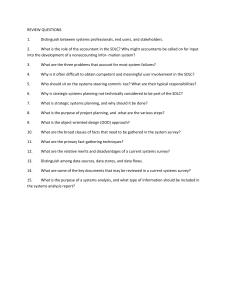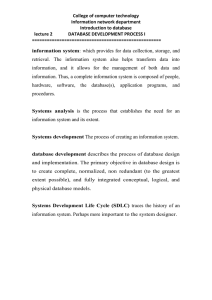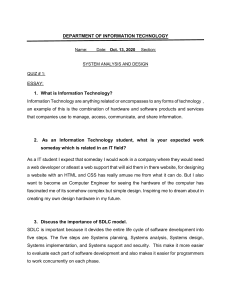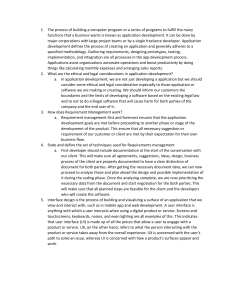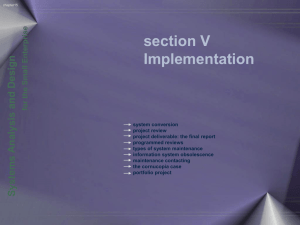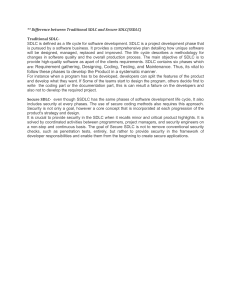SDLC Research
advertisement
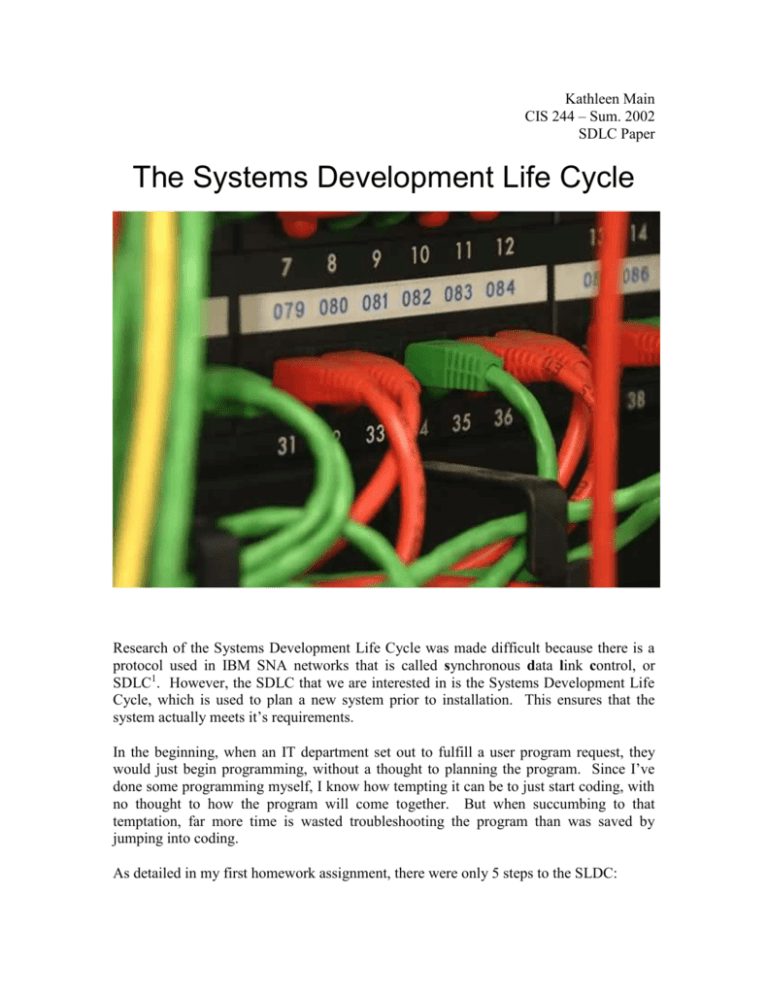
Kathleen Main CIS 244 – Sum. 2002 SDLC Paper The Systems Development Life Cycle Research of the Systems Development Life Cycle was made difficult because there is a protocol used in IBM SNA networks that is called synchronous data link control, or SDLC1. However, the SDLC that we are interested in is the Systems Development Life Cycle, which is used to plan a new system prior to installation. This ensures that the system actually meets it’s requirements. In the beginning, when an IT department set out to fulfill a user program request, they would just begin programming, without a thought to planning the program. Since I’ve done some programming myself, I know how tempting it can be to just start coding, with no thought to how the program will come together. But when succumbing to that temptation, far more time is wasted troubleshooting the program than was saved by jumping into coding. As detailed in my first homework assignment, there were only 5 steps to the SLDC: 1. 2. 3. 4. 5. Planning – gathering information about what the system currently is. Analysis – gathering the requirements of the new system. Design – creating a blueprint for the new system. Implementation – creating and installing the new system. Operation and support – keeping the new system running. However, other sources I found generally agreed that there are 6 phases of the SDLC2, 3: 1. 2. 3. 4. 5. 6. Preliminary Investigation, Initiation or Inception Analysis, Analysis and Requirements Definition Design Development, Construction Implementation, Installation or Deployment Audit & Maintenance It seems that the extra step neglected by our text is a more detailed version of Development and Construction. It seems that our text goes right from creating a blueprint to installing the system, neglecting to create a prototype of the system. Although the two steps are closely related, I believe that two separate steps best represent them. There is also a possible seventh phase that may be considered3: 7. Remove from Service/Obsolescence I believe that a Removal phase is quite appropriate to include in a systems life cycle – no system will last forever. Consider the space station Mir’s removal from service4. Certainly when planning a nuclear facility, the planners must take into account how they will take it offline. As a culmination of my research, here are the steps I believe will be most efficient and complete when working out a systems development life cycle, and the questions that need to be answered during each step: Preliminary Investigation: What are the basic requirements & functions of the proposed system? Can we complete the proposed system be in time to be useful? How much will it cost – do we have enough budgeted for it? Requirements Definition: What features are important? What do the users need it to do? What restrictions (site, environment, materials availability) are there? What software do we need? What hardware do we need to run it? What connectivity do we need? Design: What do we need the system to output? What inputs do we have available? What processing do we need to do to turn the input into the output? Is there an existing system we can leverage to do this? Can we buy a boxed product or make our own? Does the boxed product meet our requirements? If we need to build our own, what components will we need? Construction: Put all the objects gathered in the design phase. Redesign if the system does not work. Do we have sufficient training material & documentation? Deployment: Are the users and support staff trained? What bugs are there? Does everyone agree that the system meets the requirements? Maintenance: What new features are requested? What new regulations does it need to comply to? What training will new employees need? Obsolescence: What safety hazards are there? Can we trade the hardware in or recycle it? Bibliography: 1. http://www.webopedia.com/TERM/S/SDLC.html 2. “Learn to Program Visual Basic Objects” by John Smiley, Software Development Life Cycle Supplement, http://www.muskalipman.com/VBObjects/ 3. http://intranetjournal.com/articles/200201/lc_01_23_02a.html 4. http://exn.ca/Stories/2001/03/15/54.asp
